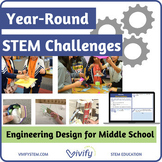STEM Oil Spill Challenge - Earth Day STEM Activity
- PDF
What educators are saying
Also included in
- Are you in need of year-round STEM activities? This growing bundle includes our most popular STEM lessons and engineering design challenges for middle school grades! Click here for more guidance on planning out a STEM class including a scope and sequence and example STEM curriculum map. Includes a SPrice $388.52Original Price $485.65Save $97.13
- Are you in need of year-round STEM activities? This growing bundle includes our most popular STEM lessons and engineering design challenges for elementary! Activities are adaptable for 1st through 5th grade with guidance provided in the teacher notes. Need help with a STEM Curriculum Map? Grab our FPrice $410.72Original Price $513.40Save $102.68
- Save 20% off individual products with this all-inclusive ocean study STEM unit! Students will explore science concepts through engaging scientific inquiry and apply an engineering mindset to two design challenges, culminating with a final project on researching and building an ocean animal observatoPrice $19.40Original Price $24.25Save $4.85
- Are you in need of year-round STEM activities? This growing bundle includes ALL Vivify K-12 STEM lessons from team challenges, engineering design, semester-long STEM units, research projects, and more! Purchase everything for 20% off individual products! Here is a sample of what is included: Stage 1Price $990.24Original Price $1237.80Save $247.56
Description
Oil Spill STEM Activity - Great for Earth Day!
Learn about the effects of an oil spill on the environment through a hands-on engineering challenge! The goal of this challenge is to clean up all of the oil from the feathers and from the water in the time provided. Students will work in teams to devise a plan to get the oil spill cleaned up in a specified time of work.
Distance learning update: Activity has been updated to accommodate distance learning including instructions on creating a materials kit and digital STEM journals that are editable in Google Slides.
Adaptable activity: This activity is adaptable for 2nd - 9th graders. Math extension problems (in both SI and metric units) target 5th - 8th grade topics including measurement, percentages, volume calculations, and ratios. Through the activity, students will understand the challenges of cleaning a major oil spill disaster and will lead to discussions on the effects on marine plants and animals. This is great for an Earth Day activity!
Read more about the Oil Spill Challenge here.
Included in this product
- Standards: Common Core Math and NGSS
- Engineering Design Process poster
- Oil Spill Lesson Plan
- Editable teach slides
- Materials list and activity suggestions
- Student handouts including information on BP Oil Spill, clean-up efforts, and environmental consequences
- Digital STEM journal in Google Slides
- Printed STEM journal for distance learning (editable in Google Slides)
- Student activity guide
- STEM Career Connection: Marine biologist, environmental engineer, environmental scientist, petroleum engineer
- Math Connection at an upper elementary and middle school level: Percentages, Measurements, Volume (*in SI and metric units*)
- Reflection Questions
Recommended Supplies:
- Tray with water and oil mixture (vegetable oil with cocoa powder)
- Feathers in the tray
- 10 jumbo Cotton balls
- Cup with dish soap (about ¼ cup or 60mL)
- 1 sponge per student
- 3 Spoons
- 1 clear plastic cup per student to collect oil
- Tarp
Looking for more STEM lessons? Our team of engineers and educators is dedicated to developing low-prep and high-quality STEM activities for any classroom! Click below to learn more:
- Vivify's Scope & Sequence + Standards Alignment
- Vivify's Resource Guide
- Learn about the 3 Stages of STEM
- Vivify STEM Membership
Customer Tips:
• Click the Green ★ to follow our store and get notifications of new products and freebies
• Leave feedback to receive TpT credit for use on future purchases
• Questions? Contact us in the Product Q&A section
♥ Connect With Us ♥
Email us: info@vivifystem.com









